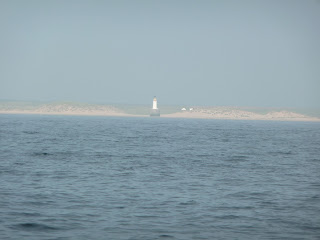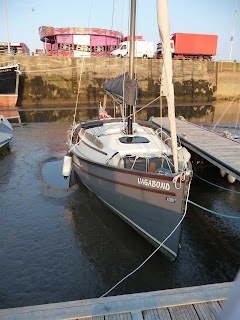I had left you all at Stonehaven, a really delightful harbour. We could only stay for one night for there was now an urgency to get on to somewhere where I could leave Vagabond and get south fairly easily. It was 06:00. Time to go. We nosed round the harbour wall and promptly disappeared into a hemisphere of visibility that had about a 50 metre* radius. There was a scraping sound under the boat and we stopped, despite Freddies’ best efforts. The depth sounder said we were in eighteen metres* of water, so we weren’t aground. I assumed we were snagged on some fishing gear that I hadn’t seen and lifted the centre board. We lurched forward a few feet** and stopped again. I looked over the stern and found a fishing float wedged between the rudder and the transom***. After a bit of pushing and prodding, we were free and resumed our noisy but almost invisible progress.
A positive squadron of Gannets flew past – the last couple having to change direction to miss us. I wondered how these birds managed to stay in stable flight in these conditions and how they navigated from place to place. Without the two GPS displays and the compass, we would have been lost within minutes of leaving the harbour.
A positive squadron of Gannets flew past – the last couple having to change direction to miss us. I wondered how these birds managed to stay in stable flight in these conditions and how they navigated from place to place. Without the two GPS displays and the compass, we would have been lost within minutes of leaving the harbour.
 |
| Cleared for attempted take off |
Gradually visibility improved but there was still no wind as we worked northward up the coast towards Peterhead. We crossed the entrance to Aberdeen, one of the centres for north sea oil and gas support vessels, so we were expecting some shipping. ....We only saw two ships.
One was a large oil tanker, way off shore, and I thought the second one was similar until I suddenly realised that it was an odd shaped support vessel, not only under way but quite close too. There we were shaping up to pass (as I thought) well clear of her stern when in fact we were crossing close to her bow.
A rapid (and obvious) course correction followed and passed astern of her.
 |
| Aberdeen entrance |
 |
| Which end is which? |
And on to Peterhead, where the yacht marina is tucked into a corner of the main harbour, behind it’s own breakwater and close to a chemical storage depot, marked ominously with danger signs.
Off to forage for petrol and food and then back to bed, only to find that a large contingent of Dutch yachts had arrived. We first met them at Hartlepool, then at Amble and now here. They, too, are going round Britain but in much bigger steps than us. Their next port of call is Lossiemouth – I think it will take us at least two days more to get there.
 |
| Peterhead Marina |
Next morning (at 05:30) we cast off and followed the Dutch fleet out of the harbour. There was Haar (of course) and a light southerly breeze.
The Dutch cohort each hoisted their spinnaker***** and disappeared. We drifted along, goose winged on the calm sea. We passed Rattray Head, the most easterly bit of Aberdeenshire and turned to the NW, drifting through swirling tide eddies. Eventually we picked up the slight west going tide drift along the north coast of Aberdeenshire. Then the wind went light northerly, so we had an unplanned gybe. We passed cliffs that were attracting the attention of a tourist boat out of Banff, so went to have a look. Serried ranks of Gannets clung with
their nests to the cliff and flew around the cliff faces. From a distance, it looked like a swarm of white midges across the cliffs.
Then across Banf Bay, past a group in a red rib watching a couple of dolphins playing around their boat. We round the last headland to look for the entrance to Whitehills harbour. There was no local boat to show us the way......
The Dutch cohort each hoisted their spinnaker***** and disappeared. We drifted along, goose winged on the calm sea. We passed Rattray Head, the most easterly bit of Aberdeenshire and turned to the NW, drifting through swirling tide eddies. Eventually we picked up the slight west going tide drift along the north coast of Aberdeenshire. Then the wind went light northerly, so we had an unplanned gybe. We passed cliffs that were attracting the attention of a tourist boat out of Banff, so went to have a look. Serried ranks of Gannets clung with
their nests to the cliff and flew around the cliff faces. From a distance, it looked like a swarm of white midges across the cliffs.
 |
| Birds on the cliff face |
 |
| Entrance to Whitehills |
 |
| Entrance to Whitehills |
 |
| Lossiemouth Harbour Entrance |
The phone rang with a timely message from the Lossiemouth Harbourmaster, telling me where to berth and where to find the keys. It was Saturday and neither he, nor his deputy would be on duty until Monday.
We found our berth, tied up and did all the things you do to tidy ship after a 7 hour passage. Now I had to find a mobile signal to find out what was happening to Mega Gran, how worried the elder sister was and how to get home. The best bet seemed to be to get Vagabond to Inverness on Sunday and take the train home on Monday. The weather forecast looked benign.
On Sunday, the weather had not read the forecast. SW, force 4 to 5. Inverness is SW of Lossiemouth. Anyway, I thought we’d give it a go. After a couple of hours butting into an increasingly white sea, I gave up. We had a lovely downwind sail back to Lossiemouth and then ran aground in the entrance. Up came the centre board and the rudder and we crept back to our original berth.
The harbourmaster turned up in the evening – he’d been to Wick and back for the weekend (by sea) and I explained my predicament. ‘No problem – we’ll move her to a quiter berth when you’ve gone. I hope all is well and give us a call when you can.’
And so the pause button was pressed......
For non metric and non boaty people
* 1 metre is about 3'4" Imperial
** 1 foot is about 300 mm
*** The transom is the flat bit of wood / metal / glass fibre that forms the stern****
of most small boats
**** the back end
***** big round sail that makes boats go really fast when sailing downwind - can be dangerous.
For non metric and non boaty people
* 1 metre is about 3'4" Imperial
** 1 foot is about 300 mm
*** The transom is the flat bit of wood / metal / glass fibre that forms the stern****
of most small boats
**** the back end
***** big round sail that makes boats go really fast when sailing downwind - can be dangerous.


































